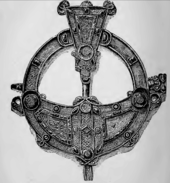Tara Brooch
The Tara Brooch is a Celtic brooch of the pseudo-penannular type, made in 650 to 750 AD. It was found in Ireland in 1850, but, despite its name, not at Tara but likely near Bettystown on the coast of County Meath. The name by which it became known was attached to the brooch by the jeweller who purchased it, as a marketing ploy for the copies they made. The brooch was exhibited internationally and was one of the artifacts that fuelled the Celtic Revival in the mid-19th century. It is now on display in the National Museum of Ireland in Dublin.
| Tara Brooch | |
|---|---|
.jpg) Front and rear views | |
.jpg) | |
| Material | silver, gold, glass, enamel, amber |
| Size | diameter 8.7 cm |
| Created | 650 to 750 AD |
| Discovered | 1850 (reportedly) Bettystown |
| Present location | National Museum of Ireland, Dublin |

The National Museum of Ireland describes it as follows: "...[T]he Tara Brooch can be considered to represent the pinnacle of early medieval Irish metalworkers’ achievement. Each individual element of decoration is executed perfectly and the range of technique represented on such a small object is astounding."[1]
Description
The brooch has a diameter of 8.7 cm and the pin has a length of 32 cm. It is made of cast and gilt silver, decorated on both front and rear. On the front are fine gold filigree panels depicting animal and abstract motifs, separated by studs of glass, enamel and amber. The back is flatter than the front, and the decoration is cast. The motifs consist of scrolls and triple spirals. Attached to the brooch by a swivel attachment is a silver chain made from plaited wire. The swivel consists of animal heads framing two small cast glass human heads.[1][2]:187
Discovery
Although the brooch is named after the Hill of Tara, traditionally seen as the seat of the High Kings of Ireland, the Tara Brooch has no connection to either the Hill of Tara or the High Kings of Ireland. The brooch was supposedly found in August 1850 on the beach at Bettystown, near Laytown, in County Meath, not far from Drogheda and some 50 km (30 mi) north of Dublin and about 25 kilometers from Tara. The finder, a peasant woman (or her two sons), claimed to have found it in a box buried in the sand, though it is likely that it was found inland, and she claimed it was found at the beach to avoid a legal claim by the landowner. It was sold to a dealer and then to the Dublin jeweller, G. & S. Waterhouse, who were already producing Celtic Revival jewellery and who renamed it the "Tara Brooch" to increase its public appeal.[3][2]:244
The brooch was made in many pieces, with much of the decoration on small "trays" or panels which were then fixed into place. When it was found only one panel of decoration was missing, but several more have since disappeared, apparently before it entered the collection of the Royal Irish Academy,[4] who later transferred their collection of antiquities to the new National Museum.
Reception in the 19th century
Celtic Revival jewellery had become very fashionable in the 1840s. Waterhouse used the Tara Brooch as the centre of displays of his replicas and imitations of Celtic brooches in his Dublin shop, also exhibiting it at The Great Exhibition in London in 1851 and the Paris Exposition Universelle, as well as the Dublin exhibition visited by Queen Victoria in 1853. Victoria liked these Celtic brooches and purchased a facsimile of the Tara Brooch at the Great Exhibition. Prince Albert had already bought two similar pieces for her when the two of them visited Dublin in 1849. Waterhouse had invented the brooch's name, choosing to link it to the site associated with the High Kings of Ireland, "fully aware that this would feed the Irish middle-class fantasy of being descended from them".[5] In 1868, the brooch was sold to the Royal Irish Academy. By the 1870s, "Tara brooch" had become a generic term for Celtic Revival brooches, some of which were by then being made by Indian workshops for export to Europe.[6][2]:244–5
See also
- Broighter Gold
- Derrynaflan Chalice
- Ardagh Chalice
- Cross of Cong
- Londesborough Brooch
References
- "Tara Brooch". National Museum of Ireland. Retrieved 7 March 2017.
- Farley, Julia; Hunter(eds.), Fraser (2015). Celts - art and identity. British Museum. ISBN 978-0-7141-2836-8.CS1 maint: extra text: authors list (link)
- Accounts of the brooch's origins and discovery vary – see Exhibition image and description, also Lynch, Michelle, "Delicate Irish Treasure" in NOW magazine, 25–31 January 2007, V. 26 N. 21
- British Museum replica brooch.
- Gere and Rudoe, 444; British Museum: Waterhouse replica of the Tara Brooch, see note above.
- Gere and Rudoe, 455
- Gere, C. and Rudoe J., Jewellery in the Age of Queen Victoria: a Mirror to the World, 2010, British Museum Publications, ISBN 0-7141-2819-8
- "NMI":Wallace, Patrick F., O'Floinn, Raghnall eds. Treasures of the National Museum of Ireland: Irish Antiquities, 2002, Gill & Macmillan, Dublin, ISBN 0-7171-2829-6
Further reading
- Boltin, Lee, ed.: Treasures of Early Irish Art, 1500 B.C. to 1500 A.D.: From the Collections of the National Museum of Ireland, Royal Irish Academy, Trinity College, Dublin, Metropolitan Museum of Art, 1977, ISBN 0-87099-164-7.
- Susan Youngs (ed), "The Work of Angels", Masterpieces of Celtic Metalwork, 6th–9th centuries AD, 1989, British Museum Press, London, ISBN 0-7141-0554-6
External links
- Tara Brooch page on the NMI website
- Treasures of early Irish art, 1500 B.C. to 1500 A.D., an exhibition catalogue from The Metropolitan Museum of Art (fully available online as PDF), which contains material on the Tara Brooch (cat. no. 32)